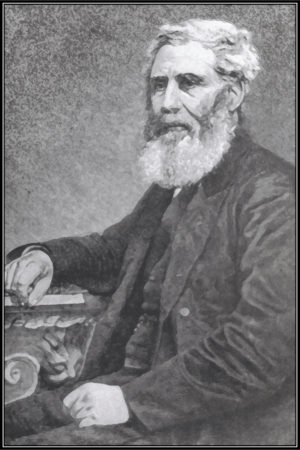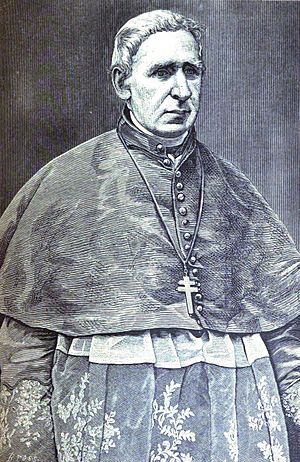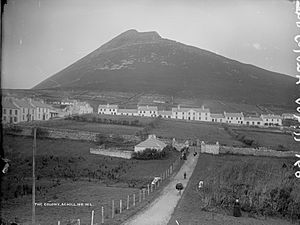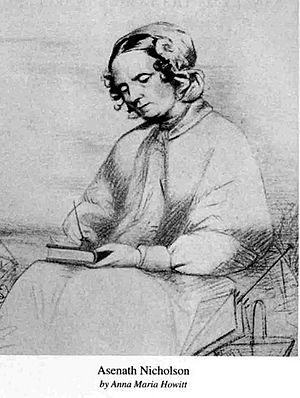Edward Nangle facts for kids
Quick facts for kids Edward Nangle |
|
|---|---|
| Missionary to Achill | |

Painting of Rev. Edward Nangle
|
|
| Church | Church of Ireland |
| Orders | |
| Ordination | 1824 |
| Personal details | |
| Born | 1799 Athboy, County Meath, Ireland |
| Died | 9 September 1883 (aged 83–84) Monkstown, County Dublin, Ireland |
| Denomination | Protestant |
Edward Nangle (1799 – 9 September 1883) was a Church of Ireland minister. He founded the Achill Mission Colony. In 1834, he started a Protestant mission on Achill Island, County Mayo. He worked there for 18 years. His goal was to share Protestantism with the local Irish Christians. Many of these people were very poor. This poverty was partly due to old laws that limited the rights of non-Protestants.
Edward Nangle wanted to encourage Catholics to become Protestant. He opened a Christian school on the island. Children learned reading, writing, farming skills, and Christianity. This was all part of his Missionary Colony. Nangle's work on the island even got attention in newspapers and in the British parliament. Achill Island also saw new developments. A pier was built at Dugort, a courthouse at Achill Sound, and new roads were made. A plaque in St. Thomas Church, Dugort, honors Edward Nangle. It says he "devoted his life from the year 1834 to the welfare of the people of Achill."
Contents
Edward Nangle's Early Life
Edward Nangle was born in Athboy, County Meath. His family had been important in Ireland for over 600 years. Even though his family was traditionally Roman Catholic, Edward was raised Protestant. This was because his mother, Catherine Nangle, was Protestant.
When Edward was nine, his mother died. Soon after, his father sent him to Cavan Royal School. It is thought he studied with Robert Daly, who later became a Bishop.
Becoming a Minister
After high school, Nangle went to Trinity College Dublin. He earned a Bachelor's Degree in 1823. He first thought about becoming a doctor. But then he decided to become a minister. He hoped this would give him a good social standing.
Nangle's decision to join the ministry was a big step in his spiritual journey. He read the Bible as part of his theological studies. He felt that reading the Bible helped him have a true conversion experience.
In the summer of 1824, he became a deacon. This was a first step in becoming a minister. He was ordained by Thomas O'Beirne, the Bishop of Meath. Nangle first worked as a curate in Athboy. Then he moved to Monkstown, County Dublin, but only stayed a short time. He finally settled in Arva, a small town near Cavan Town, for two years.
People described Edward Nangle as a "tall, thin, pale man." He spoke softly but was serious and intense. His biographer, Henry Seddal, said Nangle could be "headstrong in forming his opinions." He was also "stubborn in holding them and harsh in giving them expression." But a friend said that when he got excited, "extraordinary fire lights up his eyes."
While working in Arva, Nangle was influenced by a religious movement. Many tenants of Lord Farnham were converting from Catholicism to Protestantism. Nangle then had a nervous breakdown. During his recovery, he had a strong spiritual experience. He decided to dedicate his life to spreading Protestant beliefs.
Starting the Achill Mission Colony
How it Began
In July 1831, Edward Nangle visited Achill Island for the first time. His wife, Eliza, came with him. They arrived on a ship bringing help after famine and cholera hit Mayo and Sligo. Nangle rode a horse around the island. He wrote that the island was very quiet, with only the sound of the tide.
Nangle felt sad about the poverty and lack of spiritual guidance he saw. He decided to start the Achill Mission Colony there.
Over the next three years, Nangle bought land on the island. He also made a 31-year lease agreement with Sir Richard O’Donnell. Sir O'Donnell owned most of Achill. On July 30, 1834, Edward Nangle, his wife Eliza, and their three young daughters arrived in Dugort. They were soon joined by Nangle's helper, Joseph Duncan, and two Scripture readers. In December 1835, their friends, Dr. Neason Adams and his wife Isabella, also moved to the Colony.
On December 23, 1834, Nangle opened the Mission's first school. Forty-three children came on the first day. It was the first free school on the island. Within a few months, schools opened in Dugort, Slievemore, Cashel, and Keel. These schools taught 410 children.
In December 1835, a printing press was set up at the Mission Colony in Dugort. Friends in London and York had given it as a gift. On July 31, 1837, Nangle printed the first Achill Herald. This was a monthly Protestant newspaper. Within two years, over three thousand copies were printed each month. This was about a third of what The Times newspaper printed back then. The Achill Herald was published every month from 1837 to 1868.
Four years after moving to Achill, Edward Nangle wrote about the changes. He said the Mission Settlement had grown into a village. The once bare mountainsides now had farms and gardens. The quietness was replaced by the sounds of schools and church bells. However, the early years of the Colony were difficult. There were many arguments between Catholic leaders and the Achill Mission. Competing schools were a big part of these conflicts.
In 1838, an orphanage was built. That summer, Archbishop Trench visited the island for the first time. By 1840, a traveler could leave Dublin on a Thursday evening and be in Dugort for church on Sunday morning.
By the early 1840s, the Achill Mission Colony had grown a lot. It included two-story houses, a printing press, an orphanage, a hospital, a post office, a dispensary, a corn mill, and farm buildings. These were surrounded by fields made from wet mountain slopes. In 1842, the colony housed 56 families, with 365 people. Most of these families (45 out of 56) were originally Catholic.
During the Famine
During the early years of the Great Famine, Edward Nangle was accused of being a "soul-buyer." People said he used money meant for famine relief to convert people to Protestantism. This was especially true because the Achill Mission schools gave food to children. Edward Nangle said that giving food was the best way to help during the famine. He also said it helped with their religious program. So, the food program grew to meet the needs of the islanders.
In January 1847, the Achill Mission said it had given jobs to 4,458 workers the month before. Two thousand of these workers were Catholic. In July 1847, it was said that 5,000 out of Achill's 7,000 people were getting help from the mission. The mission had also planted 21 tons of potatoes that were not affected by the blight. In his newspaper, the Achill Missionary Herald, Nangle later said that the employment numbers were "aggregate." This meant they were total numbers over time, not at one moment.
People accused Edward Nangle of "souperism." This meant offering food or other help in exchange for religious conversion. This happened during the famine years as food was given to children in the Colony schools, and more people converted.
In autumn 1848, Thomas Plunkett, the Protestant Archbishop of Tuam, visited the island. He found over 2,000 children in the mission schools. That same year, more than 3,000 people worked for the mission. They cleared land and built roads and walls. In November 1848, a ship called the William Kennedy arrived in Achill. It carried 220 tons of Indian meal from Philadelphia. This was enough food for 2,000 people and cost £2,200 from mission funds.
In March 1848, hundreds of people from Dooniver, Bullsmouth, and Ballycroy thanked Nangle. They said he gave them potatoes and turnips during the famine. Without his help, they would have starved.
In September 1849, 400 children were confirmed at the Achill Mission. Only 28 of these children were from Protestant families. The other 372 were converts. Most of the children in the Achill Mission schools were converts.
St. Thomas Church
In 1848, a spot was chosen for a new church in Dugort. A widow from Cheltenham, England, gave £2,400 to help build it. On March 18, 1855, St. Thomas Church opened. Bishop Plunkett led the first service. Five hundred people attended, including a 107-year-old convert who walked five miles to be there.
Challenges from the Catholic Church

The Catholic Church did not support Nangle and the Achill Mission Colony from the beginning. At the first Sunday school, a Catholic man reportedly stood by the gate. He had a rod and threatened to hit children who attended. Also, one of the mission's scripture readers was attacked by two men. They threw him to the ground and tore his clothes. Nangle was warned of a secret plan to attack the colony. The plan was to kill the people, burn the buildings, and end the mission. No attack happened, but it is believed that the preparations made by the mission stopped the attackers.
In the summer of 1835, John MacHale visited Achill for the first time. He was the Catholic Archbishop of Tuam. A crowd followed him, holding banners that said, "Down the Schematics." The Archbishop led a group of thirteen priests. The priests spoke to the crowd and criticized the colony. They said bad things about anyone who joined the Protestant settlement.
In 1835, after the Mission opened schools in Dugort, Cashel, Keel, and Slievemore, the local parish priest opened three competing schools. Nangle complained about the teacher at the Dugort national school. He said the teacher had "with a knife in his hand threatened to take the head of one of the children attending a school under [mission] patronage."
In 1836, John MacHale visited Achill again. He spoke to a large crowd outdoors. He told them to promise not to have anything to do with the Achill Mission people. He said there was "no place outside of Hell which more enrages the Almighty than the Protestant colony." He also said he hoped people would stop sending their children to the colony school.
In 1837, MacHale visited again. This time, he stirred up the people against what he called "these venomous fanatics." He was talking about those involved with the Achill Mission Colony. Soon after his visit, a schoolmaster and scripture reader from the Mission Colony were beaten on Clare Island. They had to hide in a lighthouse before escaping on a coastguard boat.
In 1839, a coastguard officer named Francis Reynolds died after being hit on the head. He had been criticized by name at Catholic church services. John and Bridget Lavelle were found not guilty of his murder. The two main witnesses in the case were coached by a local Catholic priest who was very against the Mission. Nangle said the trial was a "mock" trial. Because of this and other events, a new courthouse was built at Achill Sound.
In 1848, the Achill Mission tried to raise money to buy more land on the island. The document they used described the conflicts during the Mission's first ten years. It also talked about their work during the early famine years. A big change happened in 1851. The Achill Mission bought a lot of land and became the biggest landlord on Achill Island. Soon after, Nangle moved to the parish of Skreen, County Sligo.
In 1851, Archbishop MacHale decided to buy 1,200 acres of island land. Soon after, work began on a Franciscan monastery, a school, a house for two priests, and a model farm. MacHale said he wanted to stop "mischievous speculators" who bought land in Achill to make money from "English credulity." During the building of the monastery, MacHale's workers were accused of stealing stones from Nangle's land. A court case followed, but the judge dismissed it. He said "both sides were equally to blame."
Public Opinion and Scrutiny
In the summer of 1842, Samuel and Anna Hall visited the Achill Mission. They were writing a guide book about Ireland for tourists. They looked at the mission's money and results. However, they did not like Nangle's strict approach to the people in the school, mission, and orphanage.
The Halls were at the Colony for less than two hours. But they called the Mission "a complete failure." They criticized Nangle, saying he lacked true, gentle, peace-loving Christian spirit. Samuel Hall wrote to Nangle, saying Nangle's efforts were "miserable" and that Christianity could not be "tainted by coarseness, ignorance and bigotry of which you are representative."
Edward Nangle responded by pointing out that the Halls' visit was very short. He also said that saving souls was a worthy goal for spending money.
The Halls' report, along with a similar visit by Asenath Nicholson, an American author, brought unwanted attention to the Achill Mission Colony's money. It raised questions about the organization's benefits. The Halls wrote another report in 1849, near the end of the Great Famine. This time, they were more positive. They praised the mission staff for their hard work during the famine. They said the staff "distributed with no sparing had to those who must otherwise have perished." By 1853, the Halls avoided commenting on the island. They advised visitors to make their own judgment. By then, Nangle had left Achill, but the old accusations still surrounded the Mission.
Edward Nangle's Later Life
In 1852, Nangle left Achill after 18 years. He moved to County Sligo and became Rector of Skreen. Soon after, he married for the second time, to Sarah Fetherstonhaugh.
In the early 1860s, Edward Nangle started a legal fight with Joseph Napier. Napier was one of the trustees of the Achill mission committee. The case began as a small disagreement about electing committee members. But it grew into a big court case that lasted for years. It used up a lot of the Achill estate's money.
Edward Nangle returned to Achill briefly in 1879. He wrote, "As I have now completed my 80th year, and am very infirm, I am unable to work for our dear people in Achill as I did for upwards of 40 years of my life." In 1881, he moved to Dublin. He died on Sunday, September 9, 1883, at age 84. He passed away at his home in Dublin, with his second wife, Sarah, by his side. Nangle is buried in Deansgrange Cemetery, Monkstown, in Dublin.
After Nangle's death, different opinions about him were clear among Protestants in Ireland. The Irish Ecclesiastical Gazette, a Church of Ireland newspaper, called Nangle "an Evangelical of the old school." But it also said the Achill Herald was "strangely deficient in Church teaching." The Gazette continued to criticize Nangle in another article. It said, "Everyone has their own idea of heroism... We are free to confess that the late Rev Edward Nangle was not a hero to our mind..."
In contrast, the Church Advocate newspaper, which had joined with the Achill Herald, praised him. It said that "few clergymen of the Church of Ireland were better known or more highly valued in his day." It described him as a man of "much intellectual power, a clear expositor of sound scripture, and a powerful writer."
Images for kids
See also
 In Spanish: Edward Nangle para niños
In Spanish: Edward Nangle para niños











